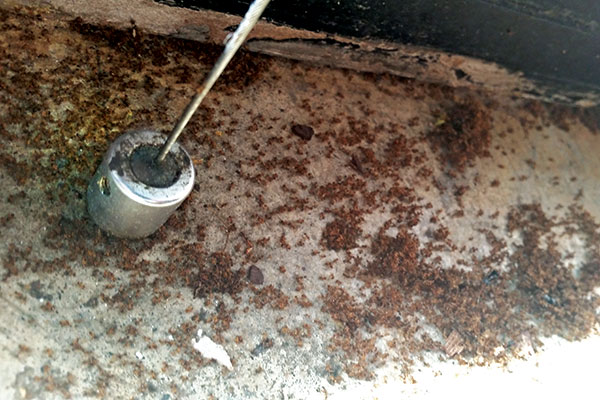“Your focus determines your reality,” as Dugas Pest Control learned firsthand.

Ants had covered his entire yard, as well as the yards of the neighbors next door and five houses down the street.
MASTER: Daniel Hill, Service Supervisor, Dugas Pest Control, Baton Rouge, La.
INVADING SPECIES: Tawny crazy ant (Nylanderia fulva)
WAR STORY: Invasive species infests entire yard, plus neighboring properties, before treatment options are widely known.
WINNING WAY: Research and education, followed by a broadcast fipronil application.
Photo: Dugas Pest Control
Daniel Hill, service supervisor of Dugas Pest Control, Baton Rouge, La., had been expecting the call for years: An invasive species of ant discovered in Texas was on the move and heading to Louisiana.
But when a frantic customer contacted Hill because ants had covered his entire yard, as well as the yards of the neighbors next door and five houses down the street, Hill’s first thought was Argentine ants. When he arrived at the home, however, Hill realized he was dealing with something he had never experienced before. The tawny crazy ant (Nylanderia fulva) — also known as the Rasberry crazy ant, discovered by Texas pest management professional (PMP) Tom Rasberry in 2002 — had arrived.
“I told the customer it was a new invasive species of ant, and that, at the time, there was no easy way to get rid of the pests, but that I was dedicated to keeping him safe and comfortable,” Hill recalls.
Hill told his customer he would eventually eliminate the ants. He soon realized it was not going to be easy.
“I started with an intense inspection, only to find every square foot of the property was occupied by the tawny crazy ants,” Hill says.
One “gigantic” tawny crazy ant colony had made a home in South Louisiana a few miles from the Mississippi River.
Hill headed back to his office to do some research. His goal was to learn how other companies were successfully battling these pests. However, at the time, not much was known about the tawny crazy ant.
“This was before we knew this species could coat itself in formic acid as a defense against fire ant venom,” Hill explains. “It was also before we knew their capacity to short out electrical panels and air conditioners, due to the number of dead ants causing it to malfunction as they send out an alarm pheromone upon their deaths, making the systems targets.”
It was also before the release of a special National Pest Management Assocation bulletin on treatment options for the species.
While Hill played detective, he recommended the customer try mechanical fixes, including manicuring the yard and disposing of leaf litter.
Before long, Hill’s research revealed that tawny crazy ants eat protein and have several queens for which they aggressively forage. So he tested a granular bait, only to realize a colony of this size would require more bait than the label at that time allowed him to use.

Evidence of a colony of tawny crazy ants in a South Louisiana neighborhood.
Photo: Dugas Pest Control
Next, Hill tried a pyrethroid with a residual in a backpack sprayer. But that didn’t work, either.
“I found that so many dead ants would blanket the insecticide, most of the colony wouldn’t even get to it,” he reports.
After conducting more research, Hill discovered Louisiana was granted a quarantine exemption to use fipronil as a broadcast treatment, and that’s what ultimately did the trick.
“We did this treatment and finally, no more ants,” he says. “The domino effect of the product solved our pyrethroid problem, and the fact that it was slower-acting gave it time to affect the entire colony.”
The customer was so appreciative of Hill’s efforts, he recommended Dugas Pest Control to his neighbors.
“The biggest challenge was taking on a new invasive species before we were taught an effective way to deal with them,” Hill says.
Hill adds that he and his team learned a lot from this job — and not just about tawny crazy ants. A combination of research and education, as well as the freedom to use trial and error with treatments, enabled the company to complete the job and satisfy the customer.
Good customer service played a role, too, Hill points out. He notes how he was honest with his customer throughout the process, telling him that, although treating tawny crazy ants was a new challenge, he was committed to solving the problem.
Hill recommends PMPs remain active and involved in the pest management industry, so when faced with a tough situation like this one, they can contact peers to gain a new perspective or get help.
“The professional pest management industry can help keep you on your toes no matter how long you’ve been controlling ants,” he concludes.
From the 2016 PMP Ant Supplement
You can reach Managing Editor Diane Sofranec at dsofranec@northcoastmedia.net.
Leave A Comment